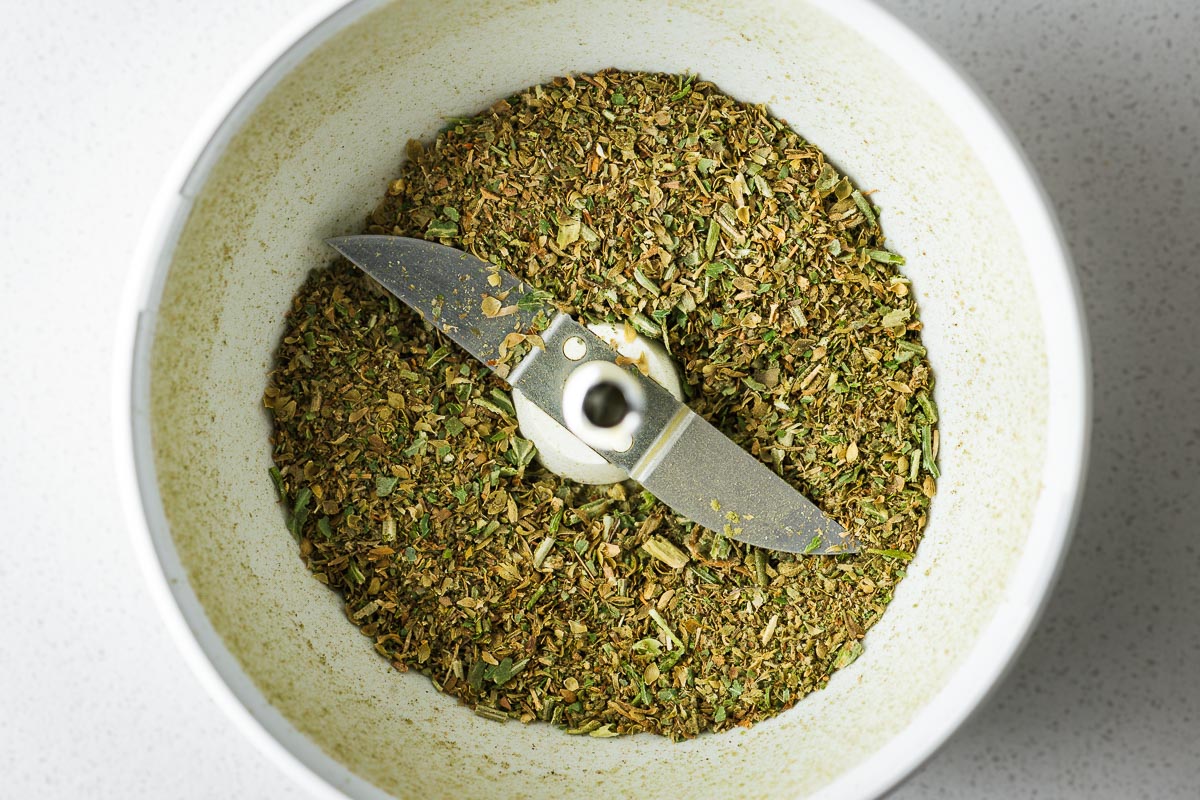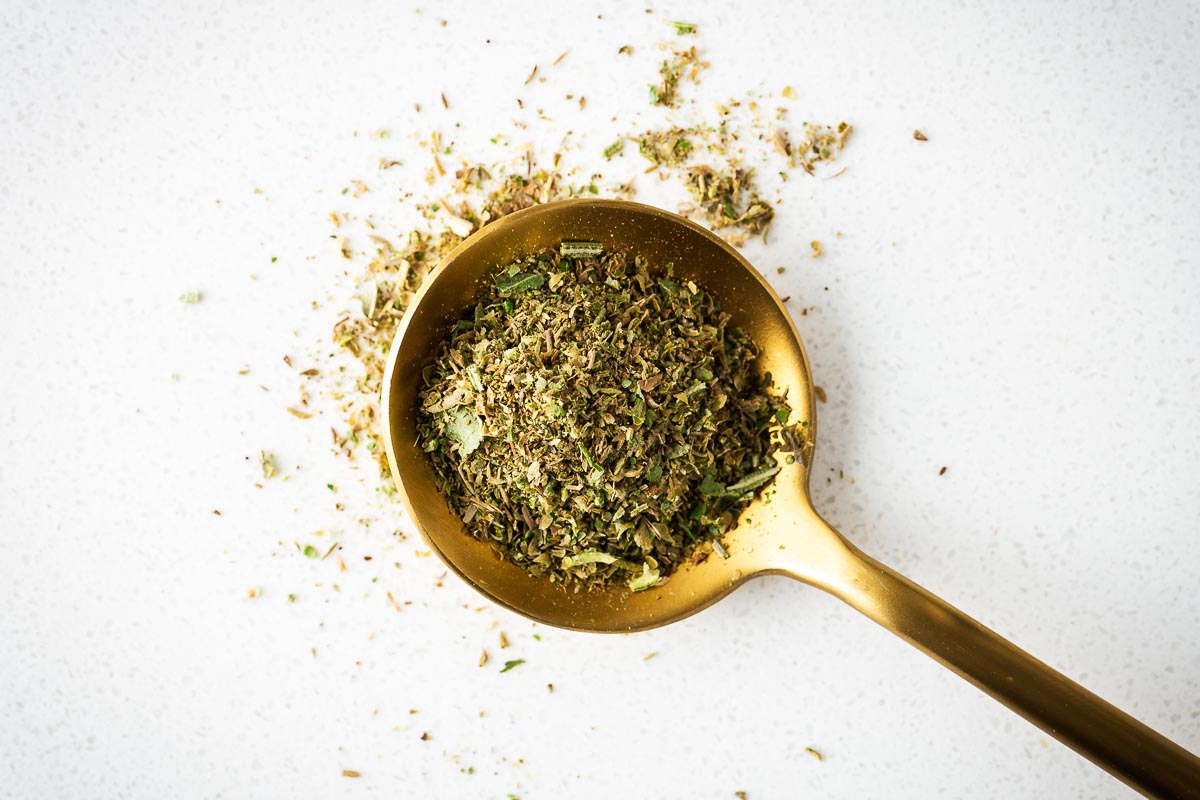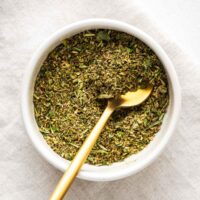The Best Italian Seasoning Substitute (+ What Not to Use)
Make the easy homemade Italian seasoning substitute – this blend of dried herbs is the best way to recreate the flavours of classic Italian seasoning. Or try another great Italian seasoning alternative from the list.
Italian seasoning is a blend of dried herbs that often include oregano, marjoram, basil, rosemary, thyme, sage or garlic powder.
Contrary to what the name suggests, Italian seasoning is an American creation. But, while store-bought herb blends are not a common ingredient in Italian grocery stores, this herb blend packs authentic Italian flavours.
There is no set recipe for Italian seasoning – the exact herb mix differs by brand. And it’s super easy to create your own delicious blend of herbs. Jump straight to the easy Italian seasoning recipe card, or browse my list of suitable alternatives to find your best Italian seasoning substitute.

The main ingredients in Italian seasoning
I scoured the virtual grocery store shelves for different brands of Italian seasoning blends. And, while no two are exactly alike, they always have some classic Italian flavours in common.
Common dried herbs in the Italian herb mix include
- oregano,
- marjoram,
- thyme,
- basil,
- rosemary,
- sage
- summer savory, and
- parsley.
A few brands also include dehydrated garlic and onion.
Almost all of the different brands of Italian seasoning use oregano or marjoram as the main ingredient. Both herbs are from the Origanum family. Marjoram (Origanum majorana) is milder and a touch sweeter compared to the woody aroma of oregano (Origanum vulgare).
I prefer a simple herb blend that contains only herbs for my homemade Italian seasoning. You can always add garlic and onion when cooking Italian dishes with your herb seasoning.
The best substitutes for Italian seasoning
Italian herb seasoning is a versatile blend of herbs packed with Italian flavour. It’s widely available in grocery stores and online. But you don’t need to stock store-bought Italian seasoning in your spice cabinet.
It’s so easy to create your own blend with what you have at home. And it’s even easier to substitute single dried herbs for Italian seasoning.
Whether you are making marinara sauce or Italian salad dressings, this list of easy Italian seasoning alternatives will help you find the best Italian seasoning substitute for you:
- Homemade Italian seasoning
- Dried oregano + thyme
- Any single dried Italian herb
- Herbes de Provence
- Pizza seasoning
- Greek seasoning
- Za’atar
- Creole seasoning
- Fresh herbs

1. Homemade Italian seasoning
It is super simple to make your own Italian seasoning blend at home. Dried oregano, thyme and basil are the most prominent Italian herbs in the classic Italian seasoning mix.
We create the best Italian seasoning substitute with plenty of different dried herbs. But don’t fret if you’re missing a few of them.
To make Italian seasoning, mix
- a tablespoon of oregano with
- two teaspoons of thyme,
- two teaspoons of basil,
- one teaspoon of marjoram and
- a half teaspoon of sage, rosemary and parsley.
Use as many of these dried herbs as possible to match the herbaceous flavour profile of Italian seasoning. But don’t worry if your spice rack is missing a few.
Find the full homemade Italian seasoning blend recipe in the recipe card below.
Some dried herbs, like whole dried rosemary leaves, can contain large pieces of dried leaf. If your herbs are very coarse, transfer the herb blend to a spice grinder or blender. And blitz until the texture is to your liking.


Transfer your homemade Italian seasoning to a spice jar or an airtight container and store your homemade spice blend in a dark, dry place. This recipe makes roughly three tablespoons of Italian seasoning.
For a spicy Italian seasoning: Add a pinch of cayenne pepper or red chilli flakes.
For pizza seasoning: Add a teaspoon each of garlic powder, onion powder and red chilli flakes to boost the savoury flavour of your aromatic herb mix.
Use your homemade Italian seasoning as a direct substitute for shop-bought Italian seasoning.
2. Dried oregano + dried thyme
Try this simple Italian seasoning substitute if your spice cabinet is not overflowing with dried herbs like mine. It relies on some basic herbs only.
Mix dried oregano with dried thyme. It makes a very good Italian seasoning substitute that you can whip up in no time. You can also use dried basil instead of dried thyme if that is what you have.
Use two teaspoons of oregano with one teaspoon of thyme to substitute a tablespoon of Italian seasoning.

3. Any single dried Italian herb
Probably the easiest substitute for Italian seasoning is to use any one of the dried herbs in a classic Italian seasoning blend.
Use any of the following dried herbs as a replacement for one teaspoon of Italian seasoning:
- a teaspoon of oregano,
- a teaspoon of marjoram,
- a teaspoon of thyme,
- a teaspoon of basil,
- a teaspoon of rosemary,
- a teaspoon of parsley, or
- a teaspoon of sage.
Learn how to dry fresh parsley in the oven. Apply the same method to dry any leftover herbs.
4. Herbes de Provence
Herbes de Provence (or herbs de Provence) is a generic term for a mixture of dried herbs considered typical of the Provence region of southeastern France.
The herb blend often contains rosemary, thyme, marjoram, tarragon, basil, mint, fennel seed, and more. But it can also contain dried lavender flowers that give the spice blend a lovely floral aroma.
There are many similarities between the two classic herb blends. It can make Herbes de Provence a great substitute if you’re in no mood to mix your own blend of herbs (or if this is what you have at home).
Smell your Herbes de Provence blend. If it is very floral, i.e. smells strongly of lavender, it’s best NOT to use it in savoury Italian dishes and pasta sauces if you want to replicate the flavour of traditional Italian cooking.
But if it has that classic herbaceous aroma of Italian herbs, use it as a direct substitute for Italian seasoning in any recipe.
5. Pizza seasoning
Pizza seasoning is another oregano-driven spice blend that makes a great substitute for Italian seasoning.
Like Italian seasoning, it’s not a spice blend you will find in Italy, but you can certainly boost the Italian flavours in your homecooked meals with these Italian-inspired blends.
Though pizza seasoning may also contain onion, garlic, red pepper flakes, bell pepper, fennel and even celery flakes, it’s an easy substitute packed with Italian flavour.
Use pizza seasoning as a direct substitute for Italian seasoning. But reduce the salt in your recipe if your pizza seasoning includes salt.
6. Greek seasoning
Similar to Italian seasoning, Greek seasoning also differs greatly between brands. However, oregano is the main herb in most Greek and Italian seasoning blends.
Oregano-driven Greek seasoning is a great alternative to use in place of Italian seasoning.
But Greek seasoning may also contain salt and black pepper. So, taste your Greek seasoning before adding it to your dish and adjust your recipe accordingly.
Use Greek seasoning as a direct substitute for Italian seasoning, but reduce the salt in your recipe accordingly. Boost the Italian flavour with a pinch of dried basil – if you have some lying around.
7. Za’atar spice blend
Za’atar is a culinary herb family (including species of thyme and oregano). It also refers to the Middle Eastern spice mix containing za’atar herbs, sesame seeds, sumac and spices.
While it has the nutty sesame flavour and acidic berry flavour of sumac, it also has a strong herb flavour from the thyme or oregano.
Za’atar is not a great substitute for Italian seasoning in classic Italian dishes and sauces.
But if you are looking for a spice blend to sprinkle over a salad or include in an olive oil-based salad dressing, za’atar may just be able to give you that fresh earthy herb flavour you are after.
Use za’atar as a direct substitute for Italian seasoning to boost flavour in salad dressings or to sprinkle over finished dishes, but not for pasta sauces and traditional Italian recipes.
8. Creole seasoning
Like Cajun seasoning, Creole seasoning is a spice and herb mix associated with Louisiana. But it tends to be more herby and less spicy than Cajun seasoning.
It can contain paprika, salt, onion powder, garlic powder, oregano, basil, thyme, black pepper, white pepper, and cayenne pepper.
Creole seasoning is more savoury thanks to the onion and garlic powder, and it’s certainly spicier than most Italian seasoning blends. But, while it’s not a perfect match for Italian seasoning in traditional Italian dishes, it will give your finished dish a savoury, herbaceous flavour boost.
Many brands already contain salt, so use it as a direct spicy substitute for Italian seasoning, but reduce the salt in your recipe to taste.
9. Fresh herbs as an Italian seasoning substitute

Dried herbs have a much more intense flavour. A general rule of thumb to convert fresh herbs to dried herbs is to use three times as many fresh herbs. Try a mix of fresh oregano, rosemary, and thyme leaves to substitute Italian seasoning in cooking.
Combine equal amounts of finely chopped oregano, rosemary and thyme leaves. You can use a small food processor instead of chopping the herbs by hand.
Fresh basil leaves lose their vibrant colour and fresh taste during cooking. Instead, finish your dish with fresh basil to boost your Italian flavours. Thinly slice fresh basil with the chiffonade method and sprinkle a tablespoon of fresh basil over your finished Italian dishes. Or scatter over whole basil leaves.
To substitute a teaspoon of Italian seasoning, use three teaspoons of chopped fresh herbs (try a teaspoon each of fresh oregano, rosemary and thyme leaves).
What NOT to use as an Italian seasoning substitute
I spotted a few odd recommendations touted on the internet as Italian seasoning alternatives. But so many of these won’t get you close to the herbaceous flavour of Italian seasoning.
Seafood seasonings, like Old Bay Seasoning and Crab Boil, have more warm spices than dried herbs and often contain celery salt as a dominant ingredient. While celery is a common ingredient in Italian cuisine, it’s not in Italian seasoning. You won’t get that Italian herb flavour of Italian seasoning with these spice mixes.
Any spice blend driven by warm spices instead of fresh Italian herb flavours won’t get you that herbaceous flavour you need. It includes spice blends like Chinese five-spice, taco seasoning, French four-spice, Lebanese seven-spice (Baharat), or ras el hanout.
You are better off using a single Italian dried herb for your Italian dish, pasta sauce or a savoury baked treat (like Italian herb and cheese bread). Or, better yet, make your own Italian seasoning at home.

Frequently asked questions
For a homemade Italian seasoning herb blend, mix dried oregano, thyme, basil, marjoram, sage, rosemary and parsley. Or try a simple Italian seasoning substitute using dried origanum and thyme.
Italian seasoning is typically a blend of dried herbs like basil, oregano, rosemary, thyme, and marjoram, sometimes including sage or parsley.
Italian seasoning and mixed herbs are similar, both containing a blend of dried herbs. But Italian seasoning blends are usually limited to traditional Italian herbs like oregano and basil.
Yes, you can substitute Herbs de Provence for Italian seasoning, though the flavour will be slightly different due to the presence of lavender and other Provençal herbs in the Herbs de Provence blend.

Ingredients
- 1 tablespoon dried oregano
- 2 teaspoons dried thyme
- 2 teaspoons dried basil
- 1 teaspoon dried marjoram
- 1 teaspoon dried parsley
- ½ teaspoon dried sage
- ½ teaspoon dried rosemary
Instructions
- Mix the dried herbs in a small mixing bowl.
- If your dried herbs are very coarse, add the herb mix to a spice grinder or small food processor and blitz until ground to your liking.
- Transfer the homemade Italian seasoning mix to a spice jar or another airtight container and use it within 6 months.
Notes
- Use as many of the different dried herbs as you have, but don’t fret if you’re missing some.
- For spicy Italian seasoning: Add a pinch of cayenne pepper powder or red chilli flakes.
- For pizza seasoning: Add a teaspoon each of garlic powder, onion powder and red chilli flakes.
